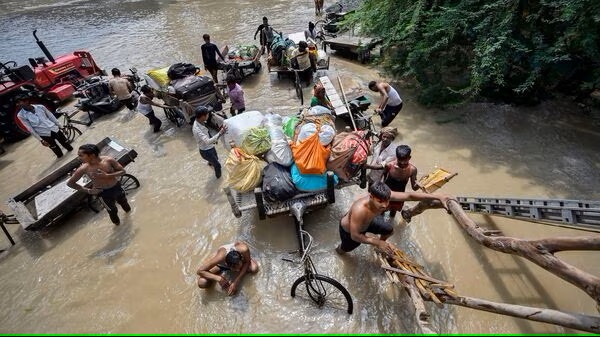Monsoon Fury and Gal Tandav in North India
Omkar Dattatray

Nature has played its spoil sport in several states of North India, where there has been unimaginable very heavy downpour for three/four days. While farmers, businessmen, and the common people wait anxiously for a good monsoon as the economy of the country as well as agriculture depend upon good monsoon.
But when rainfall exceeds its limit and continues for more days, it causes floods, landslides, and damage to the agricultural produce, properties, roads, bridges, and loss of precious human lives and the same has happened in many states of northern India and the people were taken unaware and faced the wrath and fury of nature that is of Inder Daveta who is the God of Rains.
There has been continuous rains in Delhi, Punjab, Haryana, Rajasthan, Himachal Pradesh, UP, Uttarakhand, and some other states. All these states have faced the continuous rains, floods, landslides, and damage to public and private properties. The roads in these states were merged in deep waters and there was big damage to the roads, highways, and bridges as such the means of communication and transport were affected. There were floods, landslides in north India after monsoon fury.
The weather office said that the unprecedented rainfall is due to the confluence of a western disturbance and monsoonal winds. Heavy rains across north India over the last few days led to several deaths in landslides and other rain-related incidents. The Indian Meteorological Department has predicted heavy, very heavy, and extremely heavy rainfall in 23 states in the country.
A red alert has been issued in Uttarakhand, while extremely heavy rainfall is expected in West Bengal, Sikkim, Arunachal Pradesh, and Meghalaya. The scale of damage in the entire region of north India has been captured in visuals of bridges being swept away, boulders tumbling down hills due to rain-induced landslides, and vehicles swallowed by the gushing waters.
The river Yamuna in Delhi breached the danger mark of 205.33 meters. The water level continued to rise overnight and it reached 206.32 meters. The increase in water level was due to Haryana releasing more water into the river Yamuna from Hathnikund barrage. In Delhi, floodwater rushed to the residential colonies including the posh localities and it is so obvious the nature does not distinguish between the rich and the poor.
The major roads and highways of Delhi are submerged in deep waters. Kashmiri gate, Mayur Vihar Ring road are submerged in floodwater. Red fort area is also submerged in floodwaters. Delhi government has closed all schools and colleges up to Sunday.
The life of Delhites is out of gear. Many areas of South Delhi are flooded with rainy water. It is very unfortunate that the rain does not stop but continues and this has resulted in the worst floods. People of Delhi are confined indoors because of the worst-ever flood.
The effect of flood in Delhi would have been less had the government being well prepared in advance to fight the floods, but it was not so. The flood and continuous rainfall have damaged houses, bridges, highways, and public properties besides killing several people.
The heavy and extremely heavy rainfall is not confined to Delhi only but it is continuing its destructive form in Himachal Pradesh, Punjab, Haryana, UP, Uttarakhand, Rajasthan, and some other states and there has been much damage and loss to private and government property and many people have lost their precious lives.
It seems that nature is displeased with us and he has brought havoc to these states through unprecedented rainfall and monsoon which caused floods in all these states of north India. In Haryana and Punjab, after three days of heavy rains, special teams have been deployed to assess the damage and to provide food, water, and shelter to those who have been displaced.
A flood-like situation developed in a private housing colony in Punjab’s Dera Bassi after a fresh spell of rains. The water level rose so high that boats and tractors had to be used to rescue locals who were stuck in their homes. In neighboring Himachal Pradesh, the flood situation is worse and there was big damage to houses as many houses collapsed and roads, bridges, and highways were submerged in floodwaters.
The heavy rainfall and consequent floods damaged many buildings both private and public and even hospitals were submerged in floodwaters. Kullu, Manali, and Kasauli were badly affected by floods and there was much loss to the properties of people and to the roads and bridges. In Himachal Pradesh, the worst-affected state in north India, heavy rain battered the state, leading to the deaths of 90 people and causing damage worth Rs 4000 crore.
The state’s capital Shimla reported the highest number of casualties with 11 dead. Over 500 tourists have been stranded in various parts of the state after rain-induced landslides cut off access to the areas. In Uttarakhand, the situation of rainfall and floods is also very serious and the people have been badly affected by continuous rains. Heavy rains and falling boulders killed four people and injured seven others in Uttarakhand.
Three vehicles were damaged by falling stones and boulders due to incessant rainfall and floods in the state. An orange alert has been sounded in the state with CM Pushkar Singh Dami saying that his administration remains on full alert. Further north, in Jammu and Kashmir, the Amarnath Yatra has been suspended for four days in a row due to damage to Jammu-Srinagar national highway in Ramban section. The highway was closed after heavy rain caused landslides.
As a result, 15,000 pilgrims were stranded in Jammu and other places. In Ramban and Banihal Jammu and also in the Kashmir valley, there were incessant rains for three, four days and it led to an increase in water level of river Tawi, Ujj in Jammu division, and in Jehlum in Kashmir but thank God it did not result in the floods.
There were heavy rainfall and floods in UP and Rajasthan and much damage was reported from these states as well, as the rivers flooded with the rainwaters and water submerged roads and highways and water gushed into houses of the people at various places and hundreds of people were displaced due to heavy rains and consequent floods.
Thus there is seen the sorrow spectacle of the fury of monsoon in various parts of north India but the south Indian states experience scant monsoon and have dry weather which also is a cause of concern to the people and governments there.
It is nature’s fury and spoil spot that while north India is battling with heavy rainfall and floods, the 12 south Indian states are having very scant rainfall and dryness. It seems to be the partiality and bias of the Rain God. There is no equitable rainfall and monsoon in India. It is unfortunate that while north India is having very heavy rainfall and floods, the 12 southern states are experiencing dry weather which also is no less than a misfortune. 12 Indian states face rainfall deficiency in July with southern and northeastern states among those affected.
Telangana and Karnataka report significantly lower rainfall, leading to a delay in crop sowing and water scarcity. Kerala, Bihar, Jharkhand, and Odisha also experience rain deficit. Thus despite the monsoon fury in several north Indian states, 12 south Indian states are suffering from rainfall deficiency. The western disturbance along with the monsoon season has wreaked havoc in HP, Uttarakhand, Punjab, Delhi-NCR, UP, Rajasthan, etc.
On the other hand, southern states such as Karnataka, Kerala, Telangana, Jharkhand, and Bihar, and northeastern states of Assam, Tripura, Mizoram, Meghalaya, etc., are still facing rain deficit. This follows that the nature seems not to be fair with the people and so there is more than abundant and very heavy rainfall and floods in northern India but in southern Indian states, people are facing scant and deficit rainfall which also is no less than a misfortune for the people.
However, ultimately it is the people who themselves are responsible for climate change and global warming because of which the people are facing floods in some parts of India and in other parts there is very scant or deficit rainfall.
We should learn to respect the nature and avoid felling trees and woods and also stop encroachments of the bank of rivers so that nature will be pleased with us and the natural environment and fauna and flora will be conserved for the future generations, otherwise, people have to be ready to face nature’s fury. Let us protect and conserve nature so that global warming and climate change will not enter the country and people are saved from its adverse effects.
(The author is a columnist, social and KP activist)







